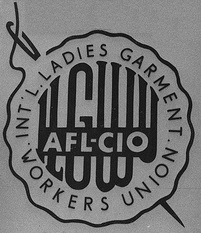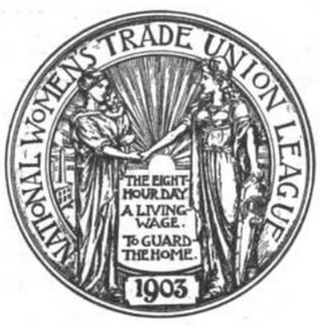A trade union or labor union, often simply referred to as a union, is an organisation of workers intent on "maintaining or improving the conditions of their employment", such as attaining better wages and benefits, improving working conditions, improving safety standards, establishing complaint procedures, developing rules governing status of employees and protecting and increasing the bargaining power of workers.

The nature and power of organized labor in the United States is the outcome of historical tensions among counter-acting forces involving workplace rights, wages, working hours, political expression, labor laws, and other working conditions. Organized unions and their umbrella labor federations such as the AFL–CIO and citywide federations have competed, evolved, merged, and split against a backdrop of changing values and priorities, and periodic federal government intervention.

The International Ladies' Garment Workers' Union (ILGWU), whose members were employed in the women's clothing industry, was once one of the largest labor unions in the United States, one of the first U.S. unions to have a primarily female membership, and a key player in the labor history of the 1920s and 1930s. The union, generally referred to as the "ILGWU" or the "ILG", merged with the Amalgamated Clothing and Textile Workers Union in the 1990s to form the Union of Needletrades, Industrial and Textile Employees (UNITE). UNITE merged with the Hotel Employees and Restaurant Employees Union (HERE) in 2004 to create a new union known as UNITE HERE. The two unions that formed UNITE in 1995 represented 250,000 workers between them, down from the ILGWU's peak membership of 450,000 in 1969.

The Women's Trade Union League (WTUL) (1903–1950) was a U.S. organization of both working class and more well-off women to support the efforts of women to organize labor unions and to eliminate sweatshop conditions. The WTUL played an important role in supporting the massive strikes in the first two decades of the twentieth century that established the International Ladies' Garment Workers' Union and Amalgamated Clothing Workers of America and in campaigning for women's suffrage among men and women workers.

Labor unions in the United States are organizations that represent workers in many industries recognized under US labor law since the 1935 enactment of the National Labor Relations Act. Their activity today centers on collective bargaining over wages, benefits, and working conditions for their membership, and on representing their members in disputes with management over violations of contract provisions. Larger trade unions also typically engage in lobbying activities and electioneering at the state and federal level.
Justice for Janitors (JfJ) is a social movement organization that fights for the rights of janitors across the US and Canada. It was started on June 15, 1990, in response to the low wages and minimal health-care coverage that janitors received. Justice for Janitors includes more than 225,000 janitors in at least 29 cities in the United States and at least four cities in Canada. Members fight for better wages, better conditions, improved healthcare, and full-time opportunities.
The Federation of Hospital And University Employees is a coalition of labor unions in New Haven, Connecticut, United States, which represents thousands of workers at Yale University and Yale New Haven Hospital. The federation currently includes recognized unions UNITE HERE Locals 34 and 35, which represent university food service, maintenance, and custodial workers, and clerical and technical workers, respectively. UNITE HERE has also, for the last fifteen years, supported the organizing efforts of graduate student teachers and researchers in the Graduate Employees and Students Organization. Finally, the Federation also includes the 150 dietary workers at Yale New Haven Hospital who are members of Local 1199NE of the Service Employees International Union (SEIU). Since 1998, this union has conducted an organizing campaign of about 1,800 other blue-collar service workers at the hospital. On March 22, 2006, the union and hospital agreed to an agreement governing the conduct of both parties in a neutral election process by which hospital employees will be able to vote on whether to unionize.
The United Cannery, Agricultural, Packing, and Allied Workers of America (UCAPAWA) was a labor union formed in 1937 and incorporated large numbers of Mexican, black, Asian, and Anglo food processing workers under its banner. The founders envisioned a national decentralized labor organization with power flowing from the bottom up. Although it was short-lived, the UCAPAWA influenced the lives of many workers and had a major impact for both women and minority workers in the union.

The history of union busting in the United States dates back to the Industrial Revolution in the 19th century. The Industrial Revolution produced a rapid expansion in factories and manufacturing capabilities. As workers moved from farms to factories, mines and other hard labor, they faced harsh working conditions such as long hours, low pay and health risks. Children and women worked in factories and generally received lower pay than men. The government did little to limit these conditions. Labor movements in the industrialized world developed and lobbied for better rights and safer conditions. Shaped by wars, depressions, government policies, judicial rulings, and global competition, the early years of the battleground between unions and management were adversarial and often identified with aggressive hostility. Contemporary opposition to trade unions known as union busting started in the 1940s, and continues to present challenges to the labor movement. Union busting is a term used by labor organizations and trade unions to describe the activities that may be undertaken by employers, their proxies, workers and in certain instances states and governments usually triggered by events such as picketing, card check, worker organizing, and strike actions. Labor legislation has changed the nature of union busting, as well as the organizing tactics that labor organizations commonly use.
Labor unions in the United States, since their early beginnings, have held various viewpoints on immigration. There were differences among the labor unions and occasionally opposition to contemporary majority opinions and public policies.
The Cannery and Agricultural Workers Industrial Union (CAWIU) was a Communist-aligned union active in California in the early 1930s. Organizers provided support to workers in California's fields and canning industry. The Cannery and Agricultural Workers Industrial Union (CAWIU) dated back to 1929 with the formation of the Trade Union Unity League (TUUL). With industrialization and the advent of the factories, labor started migrating into the urban space. An influx of immigrant workers contributed to the environment favorable to big business by increasing the supply of unskilled labor lost to the urban factories. The demand for labor spurred the growers to look to seasonal migrant workers as a viable labor source. Corporations began to look at profits and started to marginalize its workers by providing sub-par wages and working conditions to their seasonal workers. The formation of the Cannery and Agricultural Workers Industrial Union addressed and represented the civil rights of the migrant workers. Ultimately the CAWIU lost the battle, overwhelmed by the combined alliance of growers and the Mexican and state governments. The eventual abandonment of the Trade Union Unity League led to the dissolution of the CAWIU, which later emerged as the United Cannery, Agricultural, Packing, and Allied Workers of America (UCAPAWA).
The Santa Clara cannery strike occurred during the summer of 1931. Workers spontaneously walked out of canneries in order to protest a 20% cut in wages. These workers were met with violence from local authorities, and strikebreakers were brought in to replace the workers. While this strike was unsuccessful, it marked the beginning of organizing cannery workers.
The Carbon County Strikes took place in Carbon County, Utah from 1903–1904. The strikes primarily consisted of Slavic and Italian immigrant mine workers who partnered with the United Mine Workers of America strikes in Colorado to protest the dangerous working conditions of the Utah coal mines. The Carbon County strikes were considered the most important labor confrontation in the United States at the time. The Utah Fuel Company strongly opposed initiatives to unionize coal workers in Utah and were the primary opposition to the UMWA at the time. The Carbon County Strikes would ultimately fail in its attempt to unionize the coal workers of Utah simply because it "did not have enough support, either internally or externally, to win against a powerful and influential company that effectively played on radical, anti-foreign sentiments in defending its position" but it demonstrated a significant nationwide effort in strengthening unionization in the west.
In 1933 there was a cherry strike in Santa Clara, California. The main overview of the events in Santa Clara was an agricultural strike by cherry pickers against the growers or employers. As the events of the labor strike unfolded, the significance of the strike grew beyond that of the workers themselves into a broader scope within America.

Women in labor unions have participated in labor organizing and activity throughout United States history. These workers have organized to address issues within the workplace, such as promoting gender equality, better working conditions, and higher wages. Women have participated in unions including the Collar Laundry Union, the WTUL, the IWW, the ILGWU, and the UAW.

Emma Kinema is an American labor organizer and the senior campaign lead of CODE-CWA, the Communication Workers of America's Campaign to Organize Digital Employees. In the late 2010s, while working as a quality assurance tester, Kinema volunteered as a games industry organizer and co-founder of Game Workers Unite. She was hired by the CWA union in 2020 to lead their initiative to organize video game and tech workers, the first American initiative of its kind in those sectors.

Some warehouse workers of Amazon, the largest American e-commerce retailer with 750,000 employees, have organized for workplace improvements in light of the company's scrutinized labor practices and stance against unions. Worker actions have included work stoppages and have won concessions including increased pay, safety precautions, and time off. There are unionized Amazon workers in both the United States and Europe.
The 1914–1915 Fulton Bag and Cotton Mills strike was a labor strike involving several hundred textile workers from the Fulton Bag and Cotton Mills in Atlanta, Georgia, United States. The strike, which involved about 500 millworkers, began on May 20, 1914 and ended almost a year later on May 15, 1915 in failure for the strikers.
The 1964–1965 Scripto strike was a labor strike that involved workers for the Scripto company in Atlanta, Georgia, United States. The strike began on November 27, 1964, and lasted until January 9, 1965, when the company and union agreed to a three-year contract that included wage increases and improved employee benefits. The strike was an important event in the history of the civil rights movement, as both civil rights leaders and organized labor activists worked together to support the strike.
The 1937 Fleischer Studios strike was a labor strike involving workers at Fleischer Studios in New York City. The strike commenced on May 7 of that year and ended on October 12. The strike was the first major labor dispute in the animation industry and resulted in the industry's first union contracts.







